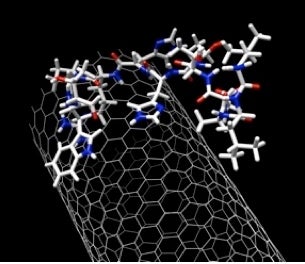Our group is interested in the application of biological chemistry to the area of nanotechnology and the fabrication of new nanosized materials. Three areas are of current interest. The first is the investigation of extremely large multisubunit proteins which contain internal cavities. These nanosized proteins may be useful as novel drug carriers and as molecular foundations for nanodevices. The second area is the molecular engineering of bacteriophages to produce nanodimensional building blocks to use in advanced biomaterials. The third area is the study of the molecular level interactions between biomolecules and nanomaterials. We have utilized phage display methods and unnatural amino acid incorporation techniques to identify peptide sequences that have strong affinity to single-walled carbon nanotubes.
Professor Honek is a member of the Waterloo Institute for Nanotechnology (WIN).
A. M. van der Ven, H. Gyamfi, U. Suttisansanee, M. S. Ahmad, Z. Su, R. M. Taylor, A. Poole, S. Chiorean, E. Daub, T. Urquhart, and J. F. Honek, 2023, Molecular Engineering of E. coli Bacterioferritin: A Versatile Nanodimensional Protein Cage. Molecules, 28(12), 4663.
F. Yang, A. Cholewinski, J. Honek, W. Wei, L. Xu, W. Zhang, M. Pope, and B. Zhao, 2022, Imparting Conformational Memory for Material Adhesion. Materials Horizon (RSC) 9, 675-687.
T. Urquhart, B. Howie, L. Zhang, K. T. Leung, and J. F. Honek, 2021, Bioconjugation of Bacteriophage Pf1 and Extension to Pf1-Based Bionanomaterials. Current Nanoscience, 17(1), 139-150 (Open Access)
Urquhart, E. Daub and J. F. Honek, 2016, Bioorthogonal Modification of the Major Sheath Protein of Bacteriophage M13: Extending the Versatility of Bionanomaterial Scaffolds. Bioconjugate Chemistry (ACS), 27, 2276-2280.
A. Ward, A. Petrie, J. F. Honek, and Xiaowu Tang, 2014, Analyte-Dependent Sensing Mechanisms: The Fabrication and Characterization of a 32-Channel Array of SWCNT-TF Chemiresistive Sensors. IEEE Nanotechnology Magazine, 8(2), 29-37.
A. Petrie, A. M. van der Ven, and J. F. Honek, 2013, Nanomaterial-based Biosensors in Biosensors and Their Applications in Healthcare: Hot Topics, eBook, Future Science Ltd., U.K.
D. Pradhan, Z. Su, S. Sindhwani, J. Honek and K. T. Leung, 2011, Electrochemical Growth of ZnO Nanobelt-Like Structures at 0 oC: Synthesis, Characterization, and in-situ Glucose Oxidase Embedment. J. Phys. Chem. C, 115, 18149-18156.
Z. Su, S. Zhu, A. Donkor, C. Tzoganakis and J. F. Honek, 2011, Controllable Delivery of Small Molecule Compounds to Targeted Cells Utilizing Carbon Nanotubes. Journal of the American Chemical Society, 133, 6874-6877.
Z. Su, K. Mui, E. Daub, T. Leung, and J. F. Honek, 2009, Interactions of Peptides with Single-Walled Carbon Nanotubes. Adv. Exp. Med. Biol. 611, 235-236.
Z. Su, K. Mui, E. Daub, T. Leung and J. F. Honek, 2007, Single-walled Carbon Nanotube Binding Peptides: Probing Tryptophan's Importance by Unnatural Amino Acid Substitution. J. Phys. Chem. B, 111, 14411-14417.
Z. Su, T. Leung and J. F. Honek, 2006, Conformational Selectivity of Peptides for Single-Walled Carbon Nanotubes. J. Phys. Chem. B, 110, 23623-23627.


A spherical protein showing its internal cavity

Model of a peptide-nanotube interaction

Unnatural amino acids in bacteriophage M13